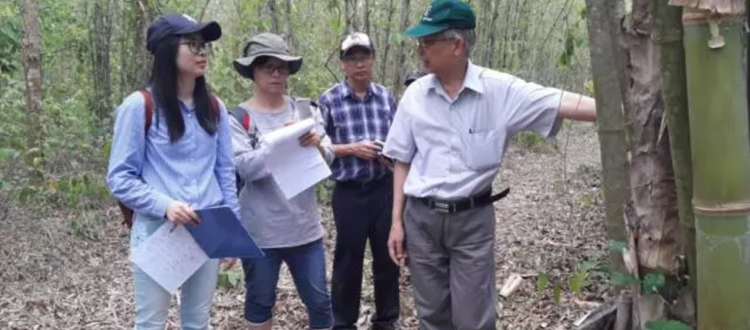Bamboo Visionaries: Improving Myanmar’s Bamboo Sector
From May 8 – 15, 2017 the GEI project team traveled to Myanmar to conduct surveys of the bamboo industry. We’ve been engaged with Myanmar bamboo industry development this year because bamboo is a renewable and versatile material that can spur economic development.

GEI project team learning about local bamboo species – GEI 2017
In October 2016, we brought representatives from Myanmar’s bamboo business association, private enterprises and NGOs to learn from China’s top bamboo processors and manufacturers.
During this recent trip, we investigated the real situation of the bamboo industry and resources in Myanmar – we even had the chance to speak with local entrepreneurs.
Take a peek into the real world of bamboo processing in Myanmar by reading the story of an industry-leader, Daw Yi Mon Thant.

A Vision for Bamboo
In a typical outdoor market in Myanmar, you’re bound to see trucks of bamboo poles, towers of woven bamboo baskets, and piles of chopsticks ready for a quick sale.
While these low value-added, small items are certainly a large part of Myanmar’s bamboo industry, they are not its future.
Daw Yi Mon Thant is one entrepreneur forging a value-added bamboo business in Myanmar.

Daw Yi Mon Thant (center) with her husband (right) and GEI’s Executive Director, Mme JIN Jiaman (left). – GEI 2017
Daw Yi Mon Thant started her bamboo-processing company about four years ago and it was one of the first of its kind in the country. Since then, she has developed a product line that goes beyond the standard, small items sold domestically to include some value-added products that appeal to foreign tastes. Case-in-point, her firm’s most popular item is bamboo flooring sold in Japan.
Although she tries not to let Myanmar’s challenging political and business environment hinder her business’s growth, there are many difficulties. Daw Yi Mon Than wants to improve her products to be more attractive and of a higher quality – perhaps like the Chinese products which are at the top of the industry. She also wants to increase production.


Bamboo handicrafts (top) vs. half-processed bamboo flooring (bottom) – GEI 2017
Daw Yi Mon Thant works hard – she travels 28 days of the month with her husband to visit their respective businesses in the northern and southern parts of the country. While the hours of travel and together time would dampen many people’s energy for work or a partner, Daw Yi Mon Thant, on the other hand, is empowered. She is rarely seen without a smile and says that “every day is like a honeymoon.”
To achieve her current business goals and find new opportunities, Daw Yi Mon Thant is studying from top bamboo processors and manufacturers in China. She is also interested in a Chinese business partner to help the business grow and expand.

A bamboo plantation in Myanmar – GEI 2017
Challenges & Opportunities of Bamboo Processing in Myanmar
Daw Yi Mon Thant’s business – and many others like it – are struggling to improve their product lines and grow their businesses in Myanmar.
Main Challenges:
1. Supply has been sharply decreasing due to a lack of resource management, planting and appropriate logging techniques.
2. Technology lags behind as most bamboo is processed manually and sold as a raw commodity, thereby leading to an inefficient and small production line.
3. Infrastructure remains a hindrance since poor road conditions make transporting bamboo difficult. Myanmar’s poor power grid also forces companies to use expensive diesel.
4. Policies including high land price, land rights, taxation, and bamboo charcoal commercialization restrictions curtail potential profits.

A natural bamboo forest (bottom) – GEI 2017
Main Benefits:
1. Resources for planting are plentiful as there are many unoccupied or degraded land that can be utilized for bamboo planting.
2. Low Cost of labor and power make potential profit margins bigger.
3. Bamboo supply has many varieties of species and the country has many good options for transporting water to the forests.

GEI Project Officers with representatives from Myanmar’s bamboo industry including, NGOs, private sector and the bamboo enterprises’ association. – GEI 2017
Future of GEI’s Work in Myanmar’s Bamboo Sector
The survey conducted by GEI in May 2017 (please see the full investigation map below) enabled greater understanding of bamboo-related enterprises, communities, NGOs, associations and governments.
Based on the forestry cooperation MOU reached by China and Myanmar last month, GEI will continue its efforts in the Government-to-Government (G2G) and Business-to-Business (B2B) cooperation between the two countries, especially for bamboo industry.
Specifically, we promote that the two nations’ governments could cooperate in policy analysis, bamboo industry planning, technology training and exemplary projects setting, as well as encourage enterprises through the investment of capital, technology and equipment via a public-private partnership or joint-venture.
Below is a map of our 2017 Bamboo Investigation:


